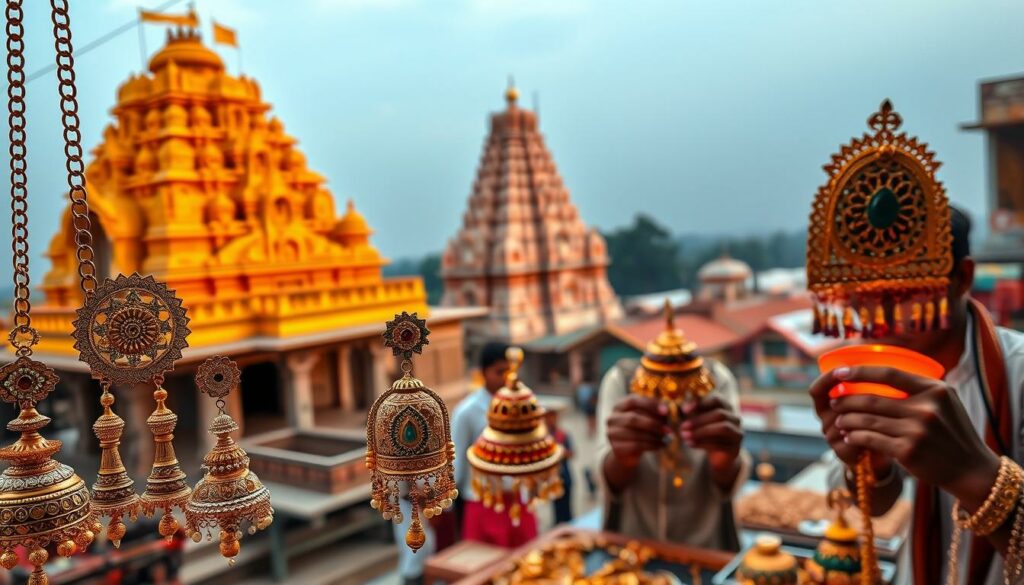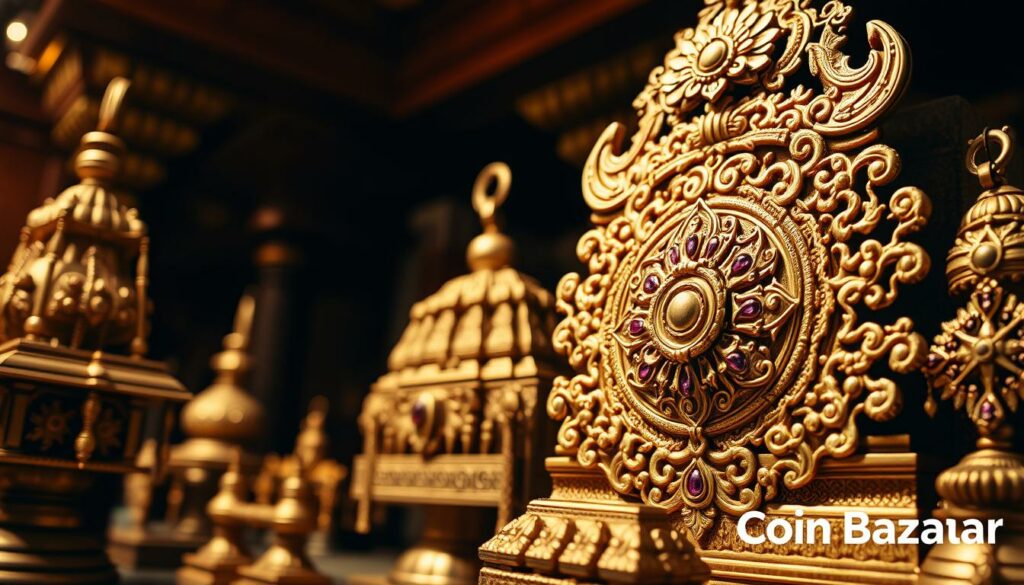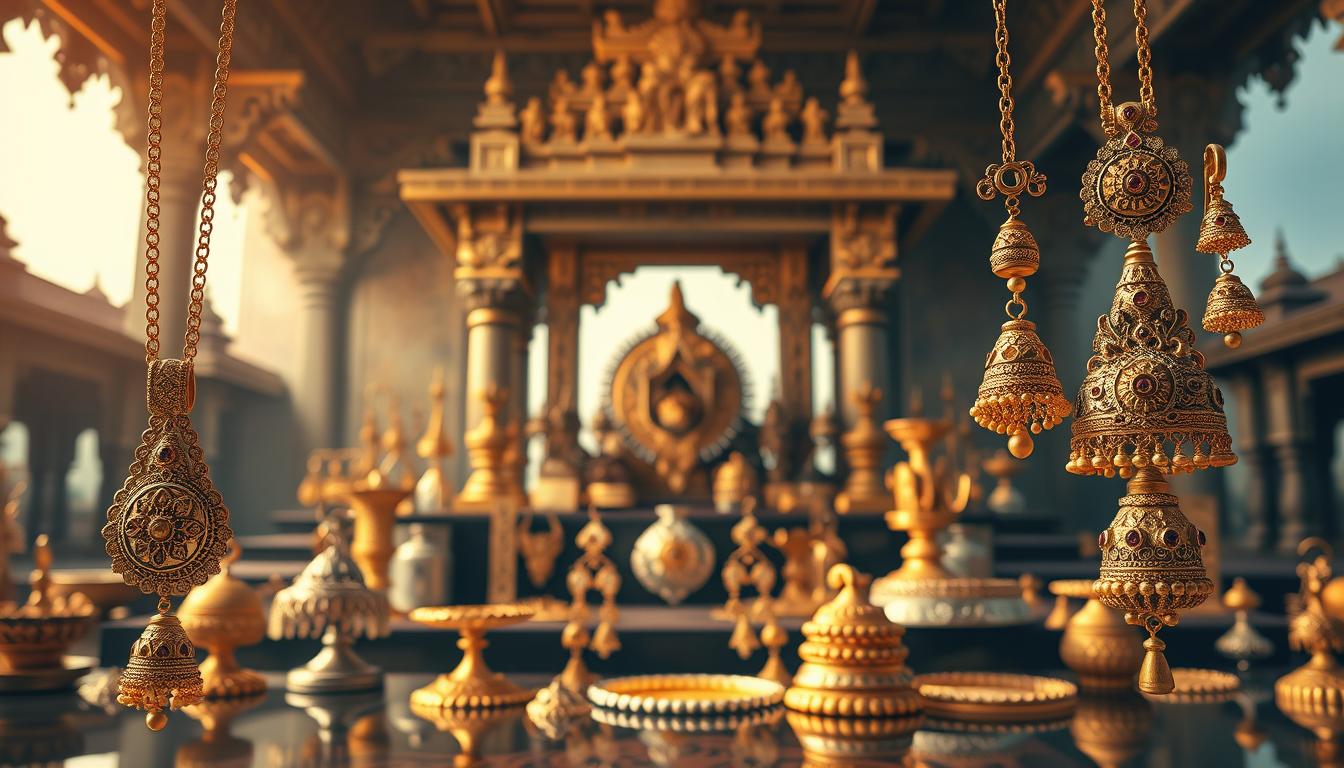Temple jewellery has been around for centuries, deeply rooted in India’s spiritual heart. You might see it on celebrities at red carpets or in bridal collections, mixing old with new. These gold pieces, once for temples and royals, are now wearable art.
Traditional Indian jewelry, like temple pieces, combines heritage with modern style. They can go with Kanjeevarams or Indo-Western outfits. Designs like peacocks and lotus flowers tell stories of skill passed down through generations. Stars like Deepika Padukone and Sonam Kapoor show these designs are always in fashion.
Every temple necklace or mathapatti has a story of history and innovation. From Nagercoil workshops to Bollywood, this trend celebrates India’s artistic heritage. When you buy temple jewellery, you connect with a legacy that’s both sacred and stylish.
Key Takeaways
- Temple jewellery originated in the 9th century Chola dynasty, symbolizing spiritual and cultural identity.
- Celebrities like Deepika Padukone and Sonam Kapoor have made temple-inspired designs a red-carpet staple.
- Modern brides now prioritize temple pieces in their trousseaus, blending tradition with contemporary aesthetics.
- Handcrafted in Nagercoil, these pieces use ancient techniques like Jadau and Meenakari, ensuring heirloom quality.
- Rising demand for sustainable luxury drives families to revive heirlooms over buying new, reducing fast-fashion trends.
The Rich Heritage of Temple Jewellery in Indian Culture
Temple jewellery is a sacred part of India’s art history. It has been around for centuries, showing the deep bond between faith and art. This bond is still alive today, as temple jewellery moves from altars to fashion.


Origins in South Indian Temples
The history of temple jewellery starts in the Chola and Pandya dynasties. Artisans made pieces from gold given to temples. These pieces first adorned deities, then inspired devotees and dancers to wear smaller versions.
Designs were inspired by temple architecture. You see lotus motifs, gopuram spires, and deity figurines. These designs turned metal into stories of faith.
Religious Symbolism and Divine Connection
Every part of temple jewellery has spiritual meaning. Nakshi patterns symbolize Lakshmi’s grace. Temple top motifs show cosmic harmony.
Wearing these pieces is more than fashion. It’s a prayer in gold. Items like vanki armlets or haram necklaces were believed to bring blessings. They combined devotion with beauty.
Evolution Through the Centuries
Temple jewellery has changed over time but kept its essence. Artisans use 22k gold and add rubies and diamonds to traditional designs. Modern tools like CAD design help keep the artistry alive.
Today, temple jewellery is both sacred and stylish. It’s timeless yet trendy, as seen in collections like Pernia’s Pop-Up Shop.
What Exactly Makes Jewellery “Temple” Style?
Temple jewellery is all about sacred designs from India’s spiritual past. It features motifs like Goddess Lakshmi, peacocks, and temple spires (gopurams

Artisans use gold or silver bases, sometimes adding gold foil for a budget-friendly option. They mix old techniques like wax casting and chiselling with new tools. This ensures the pieces are both authentic and accessible. Look for details like uncut diamonds, Kundan settings, and colorful enamel work (meenakari).
- Deity-inspired figures: Lakshmi, Ganesha, and Nandi dominate, representing luck and protection.
- Architectural elements: Gopuram arches and temple pillars translated into necklaces and earrings.
- Nature’s symbols: Lotus blossoms, elephant trunks, and leaf patterns add spiritual depth.
Modern temple jewellery keeps tradition alive while being fresh. The Manga Malai necklace, with Lakshmi coins and gems, is a favorite for brides. Even kasumala bangles, adorned with coin motifs, carry temple blessings. Brands like Sayar Jewellers blend old and new, creating art that respects heritage and appeals to today’s style.
The Distinctive Craftsmanship Behind Traditional Temple Jewellery
Every piece of handcrafted temple jewelry has a long history. Imagine artisans shaping gold into temple spires or creating gods’ forms with precision. This art dates back to the Chola dynasty in the 10th century. It still uses methods unchanged since then. Let’s see how these masterpieces are made:
- Techniques: Granulation, filigree, and engraving transform metal into art. Tiny dots (granulation) or twisted wires (filigree) look like temple carvings.
- Materials: Pure gold or silver is used, sometimes layered with gold foil for cost. Modern designs might add rubies or emeralds, but the core remains traditional.
- Process: From sketching to molding, each step takes days or even weeks. Metal is melted and molded, then polished to a mirror shine.
“Every curve is a prayer. We don’t just make jewelry; we preserve history.” — Master artisan, 5th-generation craftsperson
| Traditional Methods | Modern Updates |
|---|---|
| Hand-carved wax molds | CAD designs for precision |
| Gold billets shaped manually | Sterling silver with gold plating |
| 22-karat gold | Polki diamonds for sparkle |
Rubans, a leading brand, blends ancient skills with modern styles. Their traditional indian jewelry collections use 22-karat gold for lasting pieces. Modern lines have gold-plated items. Each piece, like a Manga Malai necklace or a Vanki armlet, has a story. When you wear temple jewelry, you carry centuries of heritage with you.
Regional Variations of Temple Jewellery Across India
Temple jewellery has its roots in South India. Yet, each region has its own style, blending local traditions. From antique south indian ornaments to northern innovations, these pieces share stories of cultural diversity. Let’s explore how regional artistry shapes these timeless designs.
| Region | Signature Style | Material & Motifs |
|---|---|---|
| Tamil Nadu | Deity-centric designs | Heavy silver, bold god figures, vibrant gemstones |
| Andhra Pradesh | Filigree mastery | Lace-like silverwork, floral patterns, delicate details |
| Karnataka | Temple architecture-inspired | Ruby accents, spire-shaped pendants, temple spire motifs |
| Kerala | Elegant minimalism | Emeralds, pearls, floral engravings, lightweight silver |
| North/West India | Fusion creativity | Blending temple motifs with local jewelry traditions |
Choosing your favorite regional style lets you honor heritage while expressing personal taste. Whether you prefer the boldness of Tamil Nadu or the elegance of Kerala, these variations ensure there’s a temple jewellery piece for every occasion. Each region’s approach showcases how traditions adapt to local aesthetics and materials, making every piece a story of its origins.
Temple Jewellery: From Sacred Artifacts to Fashion Statements
Temple jewellery was once only for gods and sacred rituals. Now, it’s a fashion must-have. These religious jewelry pieces, with designs from centuries ago, are now key for South Indian brides. A bridal temple jewelry set on a bride’s sari is more than fashion—it connects to heritage.
Back then, temple jewellery was for temple ceremonies. Now, 35% of sales are for brides, like Deepika Padukone’s Konkani wedding look. Designers make lighter versions in gold or silver, making religious jewelry wearable every day.
- Modern twists: Petite temple-inspired earrings and chokers for everyday styling
- Material innovation: 90% of authentic pieces still use uncut gems, but 22-karat gold ensures durability
- Global appeal: International celebrities now showcase these designs on runways and red carpets
Temple jewellery is perfect for weddings or casual outfits. With a 30% rise in demand, it’s clear this heritage is now a fashion icon.
Why Modern Indian Brides Are Choosing Antique South Indian Ornaments
Imagine walking down the aisle with jewelry that tells stories of centuries. Today’s brides love antique south indian ornaments and bridal temple jewelry. These pieces are more than accessories; they are family treasures that connect past and present.
Connection to Cultural Roots
- South Indian designs like the Makari malai necklace (with 536 diamonds) echo royal legacies, as seen in Chettinad’s jewelry history.
- Vummidi Bangaru Jewellers’ Annapakshi collection, priced at ₹3 crores, blends tradition with luxury, offering bridal sets that honor lineage.
Timeless Appeal vs. Fleeting Trends
“Vintage-inspired jewellery like Polki and Kundan designs captivate with their timeless beauty,” says Ms. Simran Shah of Kama Jewelry.
Antique bridal temple jewelry is made with 22k gold and natural diamonds, lasting forever. This stands in contrast to fast fashion that goes out of style quickly.
Instagram’s Role in Revival
Hashtags like #TempleBride and #HeritageJewellery show off antique south indian ornaments. Posts like NAC Jewellers’ Chettinad-inspired rakodis get 2.3 million+ followers.
| Factor | Impact |
|---|---|
| Heritage | Preserves family heirlooms passed through generations |
| Sustainability | Ethically sourced gold and gems reduce waste |
| Social Media | Instagram highlights 19th-century designs like Sotheby’s mango malai ( £50k–£70k) to global audiences |
From Diwali to weddings, these pieces become timeless treasures. They are made for a lifetime, not just a day.
Celebrity Influence on the Temple Jewellery Renaissance
Celebrities are making temple jewellery a cultural trend. Stars like Deepika Padukone and Sonam Kapoor have turned red carpets and weddings into fashion shows. Deepika’s Polki choker at her Konkani ceremony and Alia Bhatt’s Kundan sets at film events show temple jewellery is more than heritage—it’s fashion.
Think of Padmaavat or Baahubali. These films didn’t just tell stories—they showed off temple designs. Now, intricate gold motifs from South Indian temples are all the rage. Stylists work with celebrities to mix traditional indian jewelry with today’s styles.
Why does this matter to you? Celebrities make heritage pieces seem desirable. The global jewellery market, worth $350 billion, sees brands like Sabyasachi and Tanishq combining tradition and trend. Celebrities aren’t just fans—they’re change-makers. When Aishwarya Rai Bachchan wears Meenakari at a premiere, it creates demand. This is more than style—it’s a cultural comeback.
“A temple necklace isn’t just metal and gems—it’s a story. Celebrities help us see that story in a new light.”
Next time you see a star in temple jewellery, remember: their choices influence markets. The $482 billion projected industry by 2030 shows heritage designs are here to stay. Your next big moment could start with a piece that honors centuries of craftsmanship.
Modern Interpretations: How Designers Are Reimagining Sacred Temple Designs
Today, designers are making sacred temple designs fit for modern life. They mix old motifs with new styles. This way, deity-inspired accessories become everyday wear, honoring tradition and meeting today’s fashion needs.
Fusion Styles for Everyday Wear
Designers like Sangeeta Boochra combine temple themes with modern looks. They create items like simple chokers or layered necklaces with designs like peacocks or lotus flowers. These deity-inspired accessories are perfect for both casual and formal wear, showing that tradition can be stylish.
Lightweight Alternatives to Traditional Pieces
Goldsmiths are now making bangles and earrings that are light but still detailed. They use thin gold sheets and techniques like filigree and laser-cutting. A 22k gold bangle, for example, is now half as heavy but just as beautiful.
Contemporary Colors and Materials
Emeralds and sapphires add color to gold necklaces. Platinum and rose gold frames are used with sacred temple designs. Enamel accents bring brightness to bangles. Even resin and mixed metals like silver-gold make these pieces modern and lasting.
How to Identify Authentic Handcrafted Temple Jewelry
Finding real handcrafted temple jewelry requires a careful look. Here are the main signs to watch for:
- Slight imperfections: Handmade items often have small details that are not perfect.
- Material weight: Genuine temple jewelry feels heavy and has gold foil on silver.
- Reverse side details: Look for hand-soldered joints and marks from the artist on the back.
Real pieces use old methods like filigree and kundan settings. A magnet won’t stick to real gold/silver. Also, check for hallmark stamps from places like BIS India.
| Authentic Features | Mass-Produced Copies |
|---|---|
| Hand-engraved patterns | Stamped machine patterns |
| Varied gemstone sizes | Uniform gem placement |
| Smooth solder joints | Rough, visible seams |
Ask about the artisans and look for certification. Brands like Kanchi Silks or Kalyan Jewellers might let you see how they work. Prices for real pieces start at ₹15,000, going up with more gems.
The best temple jewelry has a story. It should feel unique, not just like pictures online. Trust your gut when comparing the quality of craftsmanship.
Investment Value: Why Statement Temple Pieces Are Worth Your Money
Statement temple pieces are more than just jewelry—they’re a smart investment. They are made with thick gold layers and secure settings. This makes traditional indian jewelry last for decades.
Each piece is a work of art, created by up to seven skilled artisans. This ensures top-notch craftsmanship that stands the test of time.
“A well-made temple necklace isn’t just worn—it becomes a family legacy,” says master goldsmith Rameshwar Rao of Mysore’s jewelry guild.
Here are some interesting facts:
- Gold’s value increases over time, with 24K pieces keeping 99.9% purity for better resale value.
- Antique temple designs sell for 30–50% more than modern ones at auctions, thanks to their historical value.
- Indian brides now spend 50–55% of their jewelry budget on gold, boosting demand for timeless styles.
These pieces also carry cultural significance. Owning a statement temple piece connects you to 5,000 years of tradition. From ancient Indus Valley motifs to modern designs, they offer a rich heritage.
Even lightweight versions under ₹50,000 provide a way to enter this market. They balance affordability with investment potential.
Gold prices are rising 8% each year, and demand spikes during festivals like Diwali. Temple jewelry combines heritage with wealth. It’s jewelry that earns interest while you wear it.
Styling Tips: Incorporating Deity-Inspired Accessories into Modern Wardrobes
Mixing temple jewellery with today’s outfits is a great way to blend old and new. Start with small pieces like stud earrings or delicate pendants for daily wear. A gold-plated maang tikka can elevate a simple kurta, while a minimalist temple necklace pairs well with a linen dress.
- Statement pieces: Wear a jhumka earring set with a tailored pantsuit for corporate events.
- Lay it right: Layer thin temple bangles with a stack of silver cuffs for a balanced look.
- Color coordination: Deep emerald or red outfits amplify the richness of temple jewellery’s floral motifs.
For weddings, choose full temple jewellery sets from brands like Rubans, starting at ₹299. These gold-plated pieces are perfect for festive budgets. Mix traditional chandbalis with a high-neck dress for contrast. Rubans’ antique finish looks great with both lehengas and A-line gowns.
Subtle details are key: Keep makeup simple with gold eyeshadow to highlight your accessories. Stack temple bangles with leather bracelets for a unique look. Whether it’s a Diwali party or a casual brunch, these styling tips make deity-inspired accessories versatile for any occasion.
Caring for Your Temple Jewellery Collection
Moisture causes 80% of tarnishing incidents, according to recent studies.
Proper care keeps your temple jewellery looking great for years. Follow these steps to keep your pieces in top condition.
Cleaning Methods for Different Materials
- Gold pieces: Clean with a soft cloth and mild dish soap. Avoid abrasive scrubbing.
- Silver: Polish gently. Use anti-tarnish cloths to prevent dullness.
- Gemstones or pearls: Wipe with a damp cloth. Never soak them in water.
- Avoid harsh chemicals like ammonia or bleach, which can strip plating or crack stones.
Storage Recommendations
- Wrap pieces in butter paper or acid-free tissue to avoid scratches.
- Store in airtight containers or anti-tarnish bags. Keep away from humidity.
- Use padded travel cases—30% of damage occurs during transit when not properly packed.
- Rotate pieces to reduce wear. Alternating use can extend lifespan by 20-30%.
When to Seek Professional Maintenance
- Check for loose stones, bent clasps, or fading plating. Experts recommend yearly inspections.
- 75% of jewellers advise re-polishing gold pieces every 2-3 years to maintain shine.
- Avoid DIY fixes for complex repairs. Seek artisans skilled in handcrafted temple jewelry techniques.
Maintaining temple jewellery is simple with these steps. Small efforts like drying pieces after use and avoiding perfume contact can save heirlooms from damage. Treat your collection with care, and it will remain a timeless treasure.
Conclusion: The Timeless Appeal of India’s Sacred Adornments
Sacred temple designs connect old traditions with today’s style. Pieces like the Aishwarya Temple Necklace Set or Kanaka Lakshmi Temple Ring show how heritage and fashion can go hand in hand. Made from 92.5% silver alloys, these items are both strong and beautifully crafted, lasting for years.
With online shopping, you can find many styles at great prices. Discounts of up to 40% on items from ₹509 to ₹6,799 mean you can explore over 186+ designs without spending too much.
Now, you can wear lightweight temple bangles and jhumka earrings every day. Each piece tells the story of skilled artisans who keep old techniques alive. Whether it’s a floral tikka or a pendant inspired by deities, these accessories let you show your cultural pride and stay fashionable.
As fashion trends change, temple jewelry remains a symbol of India’s creativity. By choosing to wear them, you help keep traditions alive, one beautiful piece at a time.














